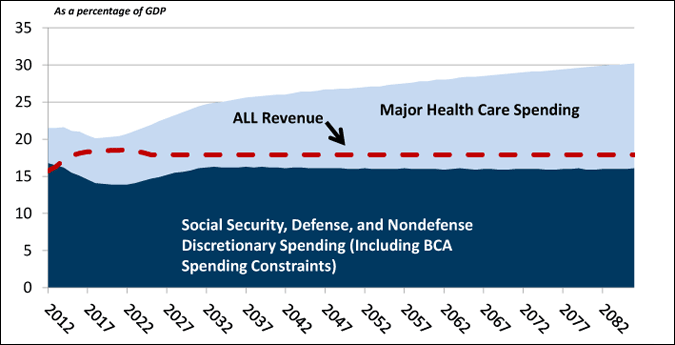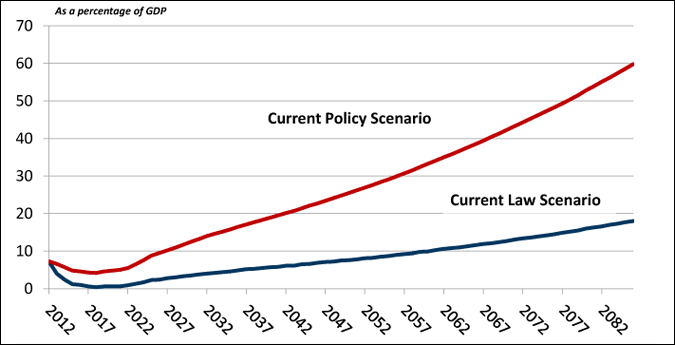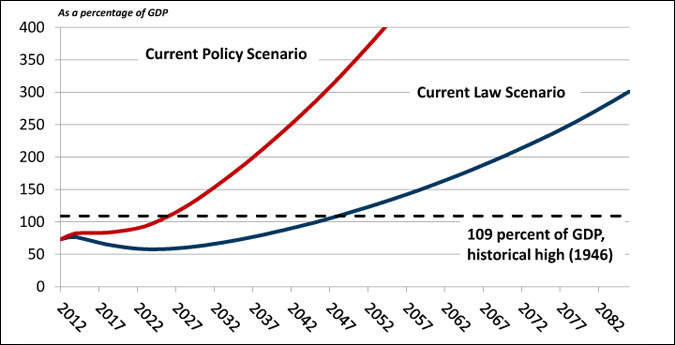You are here
Government Accountability Office Fall 2012 Budget Outlook
KEY FINDINGS
Discretionary spending limits alone do not address the fundamental structural imbalance between revenues and total federal spending. The key drivers of spending growth are the increasing cost of health care and the aging of the population. As the Baby Boomers become eligible for Medicare, more pressure will be placed on the budget. In 2011, about 7,600 Boomers become eligible for Medicare every day. By 2029, this number will grow to over 11,000 new Medicare eligible seniors a day. This demographic factor combined with the rapid growth of the cost of health care leads to an unsustainable growth in noninterest spending. Under the current policy scenario, the federal government is projected to run permanent primary spending deficits.
Under GAO's current policy scenario, growth in spending for the major health care programs is the source of all of the growth in long-term noninterest spending

SOURCE: United States Government Accountability Office, "The Federal Government's Long-Term Fiscal Outlook: Fall 2012 Update," December 2012. Available at http://www.gao.gov/special.pubs/longterm/fed/recent.html. Compiled by PGPF.
The imbalance between noninterest spending and revenues leads to a permanent primary deficit. To finance this deficit, the federal government must borrow money and pay net interest on this borrowing. Currently, this debt service costs about 1.4 percent of the gross domestic product. Under current law, this amount will double by 2025 and triple by 2041. Under current policy, by 2041 net interest will be over 8 times higher than it is today. In both scenarios, this leads to massive and unsustainable permanent unified budget deficits.
GAO's projections show a long-term structural deficit. This is due to an imbalance between revenue and spending.

SOURCE: United States Government Accountability Office, "The Federal Government's Long-Term Fiscal Outlook: Fall 2012 Update," December 2012. Available at http://www.gao.gov/special.pubs/longterm/fed/recent.html. Compiled by PGPF.
The GAO prepares two long term projections. One projection represents GAO's judgment of current law and follows CBO's August 2012 baseline through 2022. This projections includes the effects from the discretionary spending caps and the automatic enforcement procedures put in place by the Budget Control Act of 2011 (BCA). After the first 10 years discretionary spending is held at this level. Revenue and spending, other than interest on the debt, Social Security, Medicare, and Medicaid are held constant as a share of GDP. The other projection is GAO’s judgment about current policy. In the current policy scenario, the expiring tax provisions other than the payroll tax are extended to 2022, and the alternative minimum tax (AMT) is indexed for inflation through 2022. In the long-term, revenues are brought back to their historical average as a share of GDP. For the first 10 years, discretionary spending reflects the original caps set by the BCA but not the lower caps triggered by the automatic enforcement procedures. Over the long term, discretionary spending and revenue are held at historical averages. In both scenarios, debt is projected to grow to an unsustainable level.
GAO's projections show that the growth of debt is unsustainable under both current law and current policy simulations

SOURCE: United States Government Accountability Office, "The Federal Government's Long-Term Fiscal Outlook: Fall 2012 Update," December 2012. Available at http://www.gao.gov/special.pubs/longterm/fed/recent.html. Compiled by PGPF.
In the long-term, the structural imbalance is simply too large to be fixed through tax increases or spending reductions alone. In the current policy scenario, to keep the debt at today’s level, about 68 percent of GDP, spending would have to be cut immediately and permanently by about 8.3 percent of GDP or tax revenue would have to increase immediately and permanently by about 8.3 percent of GDP. This is a noninterest spending cut of about 32 percent or a tax increase of about 46 percent compared to today’s levels.
Balance is the key word from GAO’s most recent report. The Congressional Budget Office, the Government Accountability Office, and the Chairman of the Federal Reserve agree that something must be done, but the need to address the long-term structural imbalance must be weighed against actions that would harm the economy in the short-term. That means a balance between new revenue and decreased spending as well as a balance between long-term solvency and safeguards in the short-term to protect the still fragile economic recovery.
